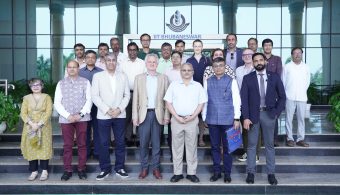Photo Credit : Vinay Shenoy, Infineon
Bullish on India: Interview with Mr Vinay Shenoy, Managing Director Infineon Technologies India

1. Infineon is an industry leader in semiconductor manufacturing. Could you please elaborate on the biggest technology trends in this industry?
Artificial Intelligence (AI) and Machine Learning (ML) technologies are rapidly accelerating, Major cloud computing providers are increasingly employing generative AI. Large language models (LLMs) are driving a surge in demand for Data Centres running specialized processors optimized for AI workloads.
While these technologies offer remarkable capabilities, they are more power-hungry compared to traditional processors and this poses a significant challenge in terms of energy consumption. Energy-efficient power stages are needed to reduce power losses and cooling efforts. Advanced power semiconductor technologies improve energy efficiency to reduce operating costs and integrate renewable energy sources such as wind & solar to reduce reliance on fossil fuel and lower carbon emissions to offset the environmental footprint.
Further, Edge Computing technologies offload AI and ML workloads to distributed edge devices, reducing the need for long-distance data transmission, thereby saving energy and improving latency as well.
Infineon is a global leader in power systems and IoT serving Electromobility, Renewable Energy, Autonomous Driving and Data Centres. We are actively doing everything possible to drive decarbonization and digitalization. We are investing heavily in R&D and manufacturing of compound semiconductors based on silicon carbide (SiC) and gallium nitride (GaN) extending the options beyond silicon-based solutions to enable highly efficient, compact end applications that consume less power.
2. How can India enable itself as a global hub for electronics manufacturing and design? What are the measures needed?
The Indian Government has made significant investments in infrastructure development such as power, transportation and logistics which are critical for the electronics industry. The industry has noticed far-reaching simplification of regulatory framework and procedures. Further streamlining will provide a more conducive business environment to attract global and domestic investment in electronics. Developing a robust domestic supply chain is crucial to reduce reliance on imports and ensure the availability of competitively priced electronic components, intermediates and services.
An end-to-end innovation eco-system of semiconductors is being established at the national level., Academic Centres of Excellence in application-oriented research are being set up at top Universities with strong industry participation, covering Integrated Sensors & MEMS, Power Electronics, 6G Systems Design & Architecture, Predictive Modelling, Semiconductor Materials: Device & Packaging Electrical Test, Electronic Substrates and Thermal Management to name some. Partnerships with international research organizations will only help expedite this process.
The electronics industry is “global for global” – a global supply chain serving global markets. This drives a highly competitive landscape. The Indian electronics Industry will need to differentiate through quality and cost efficiency and with an emphasis on innovation We are already seeing various stakeholders – both domestic and international investing in the wide value chain of electronics either directly or via partners in India.
3. How imperative is it to have an indigenous Semicon Fab in India? How will it benefit the local SMEs and suppliers in the value chain of the ecosystem?
From a long-term strategic perspective, India needs to have free access to emerging and state of art technologies emerging as a rapidly developing and geopolitically significant country. While friendly relations with countries possessing these capabilities have helped, India nevertheless needs to reduce technology dependency on others. Semiconductors are foundational to emerging technologies such as 5G, Artificial Intelligence, the Internet of Things, Autonomous Vehicles, renewable energy systems and strategic electronics. Indigenous semiconductor manufacturing combined with design and engineering capabilities enhances India’s economic stability, preparing it to lead in these transformative technologies and contribute to innovation and competitiveness on the global stage.
The mid-term benefits related to supply chain resilience, job creation, reduced trade deficits and investments in allied industries such as equipment manufacturing, special materials, chemicals and gases are relevant as well.
The value chain will offer opportunities to local industries many of whom will need to establish stronger processes to meet the unique requirements of semiconductor manufacturing such as high purity, specialized formulations, precise handling and storage, rigorous safety measures and environmental responsibility.
Overall, semiconductor manufacturing represents a strategic investment in the long-term sustainability and competitiveness of India’s economy.
4. What are Infineon Technologies’ ambitions for the Indian market? Are you doing R&D specifically for the Indian market?
Infineon provides a strong portfolio of products addressing decarbonization and digitalization tailored to the specific needs of various applications, markets and geographies, each of which has unique needs related to cost, quality and functionality. This approach empowers our customers to choose based on their value proposition to their end markets. We provide strong technical support for Indian customers to design our products into their applications rapidly.
Government investments in infrastructure and the rapidly rising disposable income among Indians enabled by an already digitalized nation are driving the consumption of electronics. Infineon’s focus on Decarbonization and Digitalization has strong relevance to India, It is committed to supporting startups, SMEs, large players and the Government and be a integral part of India’s growth.


